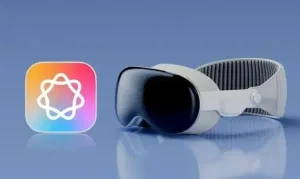Vision Pro 2 is expected to be mass-produced in 2025; Meta / WiMi leads the holographic AR layout
Since the release of Apple (AAPL), Vision Pro uses the word ‘spatial computing’, which subverts the public’s cognition of MR products, and also pulls VR products with biased entertainment attributes to the dimension of productivity.

Vision Pro 2 Mass production in the second half of the year
Guo Ming released a blog post on his Medium platform today, Apple’s Vision Pro 2 headset will be mass production in the second half of 2025, the key selling point is the combination of Apple Intelligence, and spatial computing, hardware using M5 chip, computing power is greatly improved.

The biggest design problem with the Vision Pro headset is that human-computer interaction is still not intuitive and inefficient, while Apple Intelligence / generative AI is expected to significantly improve the problem. By integrating eye-tracking, gesture control and Apple Intelligence, it is expected to provide a better spatial computing experience.
In addition, the M5 version of the Vision Pro price change may not be big, but if the new machine can create attractive user situation, apple’s head / space operation is expected to become the mainstream products, have the opportunity to head the user experience to the unimaginable, as for the cost and price drop, weight and life improvement is also will happen sooner or later.
Meta’s first holographic AR glasses were stunning unveiled
It’s worth noting that Apple’s old rival Meta (META) has just released its first holographic AR glasses, which took a decade of development, codenamed Orion. At the same time, Meta Connect 2024 also released a multi-modal large language model and a new virtual reality (VR) headset, Quest 3S, Ray-Ban glasses and Llama3.2 model, which will promote the rapid growth of the smart glasses market and space computing.

Unlike competing products such as Apple’s Vision Pro headphones, Meta’s Orion glasses do not require a bulky headband or battery pack to operate. Orion has seven cameras, two of which are used to track eye movements, so that users can control the display with visible gestures. The wristband uses electromyography to detect more subtle hand movements so the user can control the glasses with slight finger movements.
Orion can be used to play games and video conference with people around the world. If smart glasses eventually become mainstream, Meta wants to become a major player in the emerging industry, which will also help the company reduce its reliance on competitors such as Apple and Alphabet’s Google in delivering products to consumers.
The glasses represent nearly a decade of technological advances and significant financial investment from Meta, but they also offer a glimpse into Zuckerberg’s vision for the future of technology. With Meta’s release of its first holographic AR smart glasses Orion, Apple plans to launch an affordable version of MR headset and mass production of VisionPro in the future, the integration of space computing and smart hardware is becoming more and more obvious around the world.
WiMi creates a new paradigm of spatial computing
In this context, WiMi Hologram Cloud (WIMI), one of the representatives of holographic AR glasses wearable devices, has continuously laid out spatial computing in recent years to accelerating the application and implementation of cutting-edge technologies such as spatial computing, meta-universe and AI model in the industry. Up to now, the company has developed and launched a lot of cutting-edge technologies in the field of spatial computing, as well as in the fields of entertainment, education, industry and other fields, to show the technological charm of spatial computing technology to the public, and actively show the new paradigm of spatial computing entrance.
Spatial computing is not a new concept, and the promise of this technology goes far beyond gaming. Currently, WiMi has the products and technology in the field, also involved in a number of spatial computing and spatial intelligence involving virtual reality (VR), augmented reality (AR), the Internet of things (IoT) technology, on the scene layout, through the use of space computing, 3D modeling and AI technology, bring users new shopping experience, more intuitive comparison, power user shopping decisions.
In addition, artificial intelligence is experiencing a “big explosion” type of rapid development. From the point of layout, WiMi is trying to itself in content recommended AI algorithm, AI visual advantages into the core competitiveness of AR intelligent devices, in order to realize online fusion, expand space computing + AI application scenarios, further consolidate its leading position in the field of virtual digital technology, and continue to explore the possibility of future technology driven enterprise.
To sum up
In fact, according to IDC data, global AR device shipments in 2023 increased by 63.5% to 500,000 units, and are expected to reach 845,000 units in 2024, up by 85.6% year on year, much faster than other XR products. With the continuous breakthrough and application expansion of technology, AI head display and AR glasses track are hot, and it is expected to become one of the important technology products in the future. It can be predicted that the layout of global technology enterprises in the “space computing” field is accelerating, and the market prospect is broad.
Disclaimer: Community is offered by Moomoo Technologies Inc. and is for educational purposes only.
Read more
Comment
Sign in to post a comment
